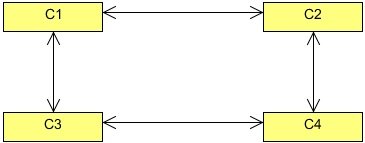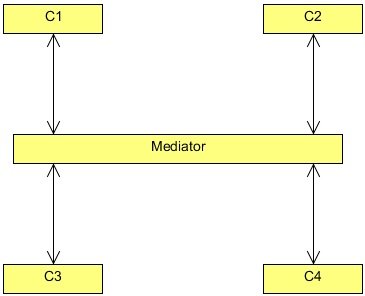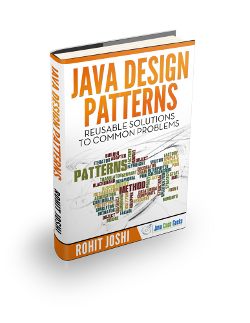Mediator Design Pattern Example
This article is part of our Academy Course titled Java Design Patterns.
In this course you will delve into a vast number of Design Patterns and see how those are implemented and utilized in Java. You will understand the reasons why patterns are so important and learn when and how to apply each one of them. Check it out here!
Table Of Contents
1. Introduction
Today’s world runs on software. Software runs in almost everything now, it is not only used in computers. Smart television, mobile phones, wrist watches, washing machines, etc. are having embedded software which operates the machine.
A big electronic company has asked you to develop a piece of software to operate its new fully automatic washing machine. The company has provided you with the hardware specification and the working knowledge of the machine. In the specification, they have provided you the different washing programs the machine supports. They want to produce a fully automatic washing machine that will require almost 0% of human interaction. The user should only need to connect the machine with a tap to supply water, load the clothes to wash, set the type of clothes in the machine like cotton, silk, or denims etc, provide detergent and softener to their respective trays, and press the start button.
The machine should be smart enough to fill the water in the drum, as much as required. It should adjust the wash temperature by itself by turning the heater on, according to the type of clothes in it. It should start the motor and spin the drum as much required, rinse according to the clothes needs, use soil removal if required, and softener too.
As an Object Oriented developer, you started analyzing and classifying objects, classes, and their relationships. Let’s check some of the important classes and parts of the system. First of all, a Machine class, which has a drum. So a Drum class, but also a heater, a sensor to check the temperature, a motor. Additionally, the machine also has a valve to control the water supply, a soil removal, detergent, and a softener.
These classes have a very complex relationship with each other, and the relationship also varies. Please note that currently we are taking only about the high level abstraction of the machine. If we try to design it without keeping much of OOP principles and patterns in mind, then the initial design would be very tightly coupled and hard to maintain. This is because the above classes should contact with each other to get the job done. Like for example, the Machine class should ask the Valve class to open the valve, or the Motor should spin the Drum at certain rpm according to the wash program set (which is set by the type of clothes in the machine). Some type of clothes require softener or soil removal while others don’t, or the temperature should be set according to the type of clothes.
If we allow classes to contact each other directly, that is, by providing a reference, the design will become very tightly coupled and hard to maintain. It would become very difficult to change one class without affecting the other. Even worse, the relationship between the classes varies, according to the different wash programs, like different temperature for different type of clothes. So these classes won’t able to be reused. Even worse, in order to support all the wash programs we need to put control statements like if-else in the code which would make the code even more complex and difficult to maintain.
To decouple these objects from each other we need a mediator, which will contact the object on behalf of the other object, hence providing loose coupling between them. The object only needs to know about the mediator, and perform operations on it. The mediator will perform operations on the required underlying object in order to get the work done.
The Mediator Pattern is best suited for this, but before implementing it to solve our problem. Let’s first know more about the Mediator Design Pattern.
2. What is the Mediator Pattern
The Mediator Pattern defines an object that encapsulates how a set of objects interact. Mediator promotes loose coupling by keeping objects from referring to each other explicitly, and it lets you vary their interaction independently.
Rather than interacting directly with each other, objects ask the Mediator to interact on their behalf which results in reusability and loose coupling. It encapsulates the interaction between the objects and makes them independent from each other. This allows them to vary their interaction with other objects in a totally different way by implementing a different mediator. The Mediator helps to reduce the complexity of the classes. Each object no longer has to know in detail about how to interact with the other objects. The coupling between objects goes from tight and brittle to loose and agile.
Before Mediator the interaction between the classes might look like this, containing references of each other.
Now, after implementing a Mediator the interaction between the classes looks like this, only containing a reference to the mediator.
The Mediator design pattern should be your first choice any time you have a set of objects that are tightly coupled. If every one of a series of objects has to know the internal details of the other objects, and maintaining those relationships becomes a problem, think of the Mediator. Using a Mediator means the interaction code has to reside in only one place, and that makes it easier to maintain. Using a mediator can hide a more serious problem: If you have multiple objects that are too tightly coupled, your encapsulation may be faulty. It might be time to rethink how you’ve broken your program into objects.
Let’s look a more formal structure of the Mediator Pattern.
The classess which hold reference of the mediator are called colleagues. The major participants of the Mediator Pattern are:
- Mediator: Defines an interface for communicating with Colleague objects.
- ConcreteMediator: Implements cooperative behavior by coordinating Colleague objects. It also knows and maintains its colleagues.
- Colleague Classes: Each Colleague class knows its Mediator object. Each colleague communicates with its mediator whenever it would have otherwise communicated with another colleague.
3. Implementing the Mediator Pattern
Now, we will see how the Mediator Pattern will make the washing machine design better, reusable, maintainable and loosely coupled.
package com.javacodegeeks.patterns.mediatorpattern;
public interface MachineMediator {
public void start();
public void wash();
public void open();
public void closed();
public void on();
public void off();
public boolean checkTemperature(int temp);
}
The MachineMediator is an interface which acts as a generic mediator. The interface contains operations call by one object to another.
package com.javacodegeeks.patterns.mediatorpattern;
public interface Colleague {
public void setMediator(MachineMediator mediator);
}
The Colleague interface has one method to set the mediator for the concrete colleague’s class.
package com.javacodegeeks.patterns.mediatorpattern;
public class Button implements Colleague {
private MachineMediator mediator;
@Override
public void setMediator(MachineMediator mediator){
this.mediator = mediator;
}
public void press(){
System.out.println("Button pressed.");
mediator.start();
}
}
The above Button class is a colleague class which holds a reference to a mediator. The user press the button which calls the press() method of this class which in turn, calls the start() method of the concrete mediator class. This start() method of the mediator calls the start() method of machine class on behalf of the Button class.
Later, we will see the structure of the mediator class. But now let’s us first see the rest of the colleague classes.
package com.javacodegeeks.patterns.mediatorpattern;
public class Machine implements Colleague {
private MachineMediator mediator;
@Override
public void setMediator(MachineMediator mediator){
this.mediator = mediator;
}
public void start(){
mediator.open();
}
public void wash(){
mediator.wash();
}
}
The above Machine class which hold a reference to the mediator has the start() method which is called on the press of the button by the mediator class as discussed above. The method has an open() method of the mediator which in turn calls the open() method of the Valve class in order to open the valve of the machine.
package com.javacodegeeks.patterns.mediatorpattern;
public class Valve implements Colleague {
private MachineMediator mediator;
@Override
public void setMediator(MachineMediator mediator){
this.mediator = mediator;
}
public void open(){
System.out.println("Valve is opened...");
System.out.println("Filling water...");
mediator.closed();
}
public void closed(){
System.out.println("Valve is closed...");
mediator.on();
}
}
The Valve class has two methods, an open() method which is called to open the valve and when the water is filled it called the closed() method. But please note that it is not calling the closed() method directly, it calls the closed() method of the mediator which invokes the method of this class.
On closing the valve it turns the heater on but again by invoking the mediator’s method instead of directly calling the heater’s method.
package com.javacodegeeks.patterns.mediatorpattern;
public class Heater implements Colleague {
private MachineMediator mediator;
@Override
public void setMediator(MachineMediator mediator){
this.mediator = mediator;
}
public void on(int temp){
System.out.println("Heater is on...");
if(mediator.checkTemperature(temp)){
System.out.println("Temperature is set to "+temp);
mediator.off();
}
}
public void off(){
System.out.println("Heater is off...");
mediator.wash();
}
}
The heater’s on() method switch on the heater and set the temperature as required. It also checks if temperature is reached as required, it turns off() the method. The checking of the temperature and switching off the heater is done through the mediator.
After switching off, it calls the wash() method of the Machine class through the mediator to start washing.
As stated by the company, the washing machine has a set of wash programs and the software should support all these programs. The below mediator is actually one of the washing programs for the machine. The below mediator is set as a washing program for cottons, so parameters such as temperature, drum spinning speed, level of soil removal etc., are set accordingly. We can have different mediators for different washing programs without changing the existing colleague classes and thus providing loose coupling and reusability. All these colleague classes can be reused with others washing programs of the machine.
package com.javacodegeeks.patterns.mediatorpattern;
public class CottonMediator implements MachineMediator{
private final Machine machine;
private final Heater heater;
private final Motor motor;
private final Sensor sensor;
private final SoilRemoval soilRemoval;
private final Valve valve;
public CottonMediator(Machine machine,Heater heater,Motor motor,Sensor sensor,SoilRemoval soilRemoval,Valve valve){
this.machine = machine;
this.heater = heater;
this.motor = motor;
this.sensor = sensor;
this.soilRemoval = soilRemoval;
this.valve = valve;
System.out.println(".........................Setting up for COTTON program.........................");
}
@Override
public void start() {
machine.start();
}
@Override
public void wash() {
motor.startMotor();
motor.rotateDrum(700);
System.out.println("Adding detergent");
soilRemoval.low();
System.out.println("Adding softener");
}
@Override
public void open() {
valve.open();
}
@Override
public void closed() {
valve.closed();
}
@Override
public void on() {
heater.on(40);
}
@Override
public void off() {
heater.off();
}
@Override
public boolean checkTemperature(int temp) {
return sensor.checkTemperature(temp);
}
}
The CottonMediator class implements the MachineMediator interface and provides the required methods. These methods are the operations that are performed by the colleague objects in order to get the work done. The above mediator class just calls the method of a colleague object on behalf of another colleague object in order to achieve this.
There are also some other supporting classes:
package com.javacodegeeks.patterns.mediatorpattern;
public class Sensor {
public boolean checkTemperature(int temp){
System.out.println("Temperature reached "+temp+" *C");
return true;
}
}
Sensor class is used by the Heater to check the temperature.
package com.javacodegeeks.patterns.mediatorpattern;
public class SoilRemoval {
public void low(){
System.out.println("Setting Soil Removal to low");
}
public void medium(){
System.out.println("Setting Soil Removal to medium");
}
public void high(){
System.out.println("Setting Soil Removal to high");
}
}
SoilRemoval class is used by the Machine class.
In order to feel the advantages and power of the Mediator Pattern, let’s take another mediator that is used as a washing program for denims. Now we just need to create a new mediator and set the rules in it to wash denims: rules like temperature, and the speed at which drum will spin, whether softener is required or not, the level of the soil removal, etc. We don’t need to change anything in the existing structure. No conditional statements like “if-else” are required, something that would increase the complexity.
package com.javacodegeeks.patterns.mediatorpattern;
public class DenimMediator implements MachineMediator{
private final Machine machine;
private final Heater heater;
private final Motor motor;
private final Sensor sensor;
private final SoilRemoval soilRemoval;
private final Valve valve;
public DenimMediator(Machine machine,Heater heater,Motor motor,Sensor sensor,SoilRemoval soilRemoval,Valve valve){
this.machine = machine;
this.heater = heater;
this.motor = motor;
this.sensor = sensor;
this.soilRemoval = soilRemoval;
this.valve = valve;
System.out.println(".........................Setting up for DENIM program.........................");
}
@Override
public void start() {
machine.start();
}
@Override
public void wash() {
motor.startMotor();
motor.rotateDrum(1400);
System.out.println("Adding detergent");
soilRemoval.medium();
System.out.println("Adding softener");
}
@Override
public void open() {
valve.open();
}
@Override
public void closed() {
valve.closed();
}
@Override
public void on() {
heater.on(30);
}
@Override
public void off() {
heater.off();
}
@Override
public boolean checkTemperature(int temp) {
return sensor.checkTemperature(temp);
}
}
You can clearly see the differences between the two mediator classes. There is different temperature, spinning speed is also different and no softener is required for the denim wash.
Now test these mediators.
package com.javacodegeeks.patterns.mediatorpattern;
public class TestMediator {
public static void main(String[] args) {
MachineMediator mediator = null;
Sensor sensor = new Sensor();
SoilRemoval soilRemoval = new SoilRemoval();
Motor motor = new Motor();
Machine machine = new Machine();
Heater heater = new Heater();
Valve valve = new Valve();
Button button = new Button();
mediator = new CottonMediator(machine, heater, motor, sensor, soilRemoval, valve);
button.setMediator(mediator);
machine.setMediator(mediator);
heater.setMediator(mediator);
valve.setMediator(mediator);
button.press();
System.out.println("******************************************************************************");
mediator = new DenimMediator(machine, heater, motor, sensor, soilRemoval, valve);
button.setMediator(mediator);
machine.setMediator(mediator);
heater.setMediator(mediator);
valve.setMediator(mediator);
button.press();
}
}
The above program will have as a result the following output:
.........................Setting up for COTTON program......................... Button pressed. Valve is opened... Filling water... Valve is closed... Heater is on... Temperature reached 40 *C Temperature is set to 40 Heater is off... Start motor... Rotating drum at 700 rpm. Adding detergent Setting Soil Removal to low Adding softener ****************************************************************************** .........................Setting up for DENIM program......................... Button pressed. Valve is opened... Filling water... Valve is closed... Heater is on... Temperature reached 30 *C Temperature is set to 30 Heater is off... Start motor... Rotating drum at 1400 rpm. Adding detergent Setting Soil Removal to medium No softener is required
In the above class, we created the objects required, mediators (or we can say different wash programs), then we set the wash programs to the colleagues and vice-versa, and the we called the start() method on the button object to start the machine. The rest is done automatically without any human interaction.
Please note that just to work with a different wash program, a different mediator is set and the rest remains the same. You can clearly see the differences from the output.
4. When to use the Mediator Pattern
- A set of objects communicate in well-defined but complex ways. The resulting interdependencies are unstructured and difficult to understand.
- Reusing an object is difficult because it refers to and communicates with many other objects.
- A behavior that’s distributed between several classes should be customizable without a lot of sub-classing.
5. Mediator Pattern in JDK
Design Patterns are used almost everywhere in JDK. The following are the usages of the Mediator Pattern in JDK.
java.util.concurrent.ScheduledExecutorService(allscheduleXXX()methods)java.util.concurrent.ExecutorService(theinvokeXXX()andsubmit()methods)java.util.concurrent.Executor#execute()java.util.Timer(allscheduleXXX()methods)java.lang.reflect.Method#invoke()
6. Download the Source Code
This was a lesson on Mediator Pattern. You may download the source code here: MediatorPattern-Project







Great tutorial on Mediator Pattern. You seem to be missing the motor.java class code listing.